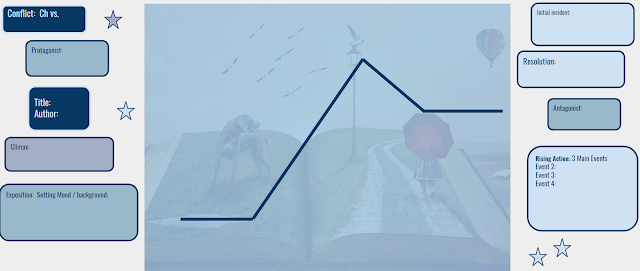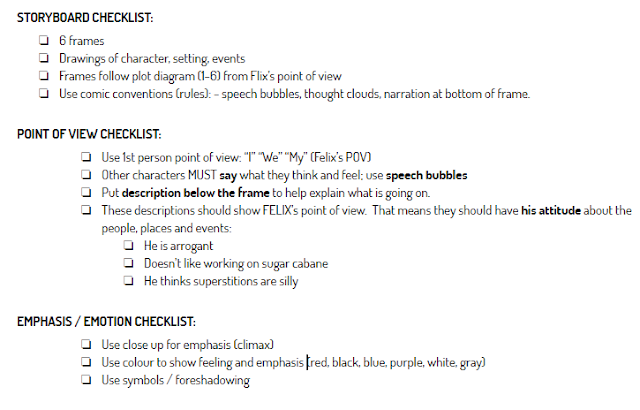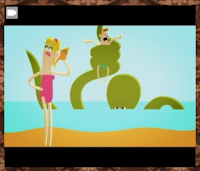The Brilliance of Short Stories

What are some skills good readers use to better understand texts?
I apply and explain effective procedures for identifying and comprehending words in context; adjust procedures according to the purpose for reading and the complexity of the texts 2.1.8
How can I build an understanding of texts through meaninful discussion with my peers?
- I discuss how interpretations of the same text might vary, according to the prior knowledge and experience of various readers 2.1.1
- I analyze how the choices and motives of characters portrayed in oral, print and other media texts provide insight into those of self and others 2.2.7
- I use own words to summarize and record information in a variety of forms; paraphrase and/or quote relevant facts and opinions; reference sources 3.3.4
What are some key characteristics of narratives?
- I evaluate the effectiveness of oral, print and other media texts, considering the believability of plot and setting, the credibility of characters, and the development and resolution of conflict 2.3.2
How do literary techniques add meaning and enjoyment of texts?
- I discuss how techniques, such as irony, symbolism, perspective and proportion, communicate meaning and enhance effect in oral, print and other media texts 2.2.11
- I analyze creative uses of language and visuals in popular culture, such as advertisements, electronic magazines and the Internet; recognize how imagery and figurative language, such as metaphor, create a dominant impression, mood and tone 2.3.8
How can I compare the development of character, plot and theme in two texts?
- I compare the development of
character, plot and theme in two
oral, print or other media texts 2.3.3
PLOT REVIEW
Students reviewed plot by watching some pixar short films and completing a plot diagram, summary and an evaluation of the development and resolution of the conflict.
Reading Strategies
We brainstormed the things we do before, during and after reading. See the image below:
Then we examined some more and selected a few we want to know more about.
"GORE"
Before reading "Gore" we formed 4 blobs and shared some of the experiences we encounter in our own lives that landed us in the blob.
Then we read the story highlighting vocabulary and STOPPING to discuss: narrative hooks, character personality, figurative language and theme.
AFTER READING ACTIVITIES:
1. Students discussed and applied context clue strategies to define words in the text.
2. We reviewed figurative language by completing a chart and examples
3. We discussed dominant impression, mood and tone that figurative language and imagery can create in a scene.
Students anlyzed several scenes and annotated text with five senses symbols and highlighted the strongest examples of figurative language contributing to mood.
See example below:

Completed this activity for a scene in "Gore" and self-assessed using the rubric below:
Draw Label Caption Rubric Name: _____________________________
Checklist:
I sketch an image that includes plot, setting and character.
I label the scene with 5-7 quotes from the story.
I include imagery, figurative language which work together to create a dominant impression. (use character’s thoughts, details found in narration about setting and actions)
I explain the dominant impression in the caption. (what effect is the author trying to create?)
I analyze creative uses of language and recognize how imagery and figurative language, such as SHAMPOO, create a dominant impression, mood and tone. 2.3.8
|
Excellent
|
My sketch is complete as it includes important details from the scene. (setting, character, plot).
The labels are very effective. They are vivid examples of imagery and figurative language which work together to create dominant impression, tone and mood.
I have clearly explained the dominant impression in the caption.
|
Proficient
|
My sketch seems close to complete as it includes details from the scene. (setting, character, plot).
The labels are effective. They are descriptive examples of imagery and figurative language which work together to create dominant impression, tone and mood.
I have clearly explained the dominant impression in the caption.
|
Satisfactory
|
My sketch seems partially complete as it includes some details from the scene. (setting, character, plot).
The labels are sometimes effective. They are less important examples of imagery and figurative language which work together to create dominant impression, tone and mood.
I have a straightforward explanation of the dominant impression in the caption.
|
Limited
|
My sketch seems incomplete as it includes few details from the scene. (setting, character, plot).
The labels are sometimes effective. They are unclear examples of imagery and figurative language which work together to create dominant impression, tone and mood.
I have an ineffective explanation of the dominant impression in the caption.
|
Use your picture and explain how imagery and figurative language create a dominant impression, mood, and tone.
The dominant impression of my scene is…
This is created by…
|
Students wrote a journal entry to retell events from the day from Amy or Lucas's perspective and used
vocabulary to improve credibility.
See exemplar below:
Amy’s Daily Complaint Journal: Dealing with a Book Thief
What a day! I am patting myself on the back right now. I am amazing. Perfect. Outstanding. Today I managed to give one of the best performances of my career, and Lucas- microbrain that he is - totally fell for it. It all started as I was lounging on the couch. Then WHAP, Lucas comes from out of nowhere and steals my book. I was so annoyed! He interrupted me at a choice part too. The babysitter was about to go check in on the baby and noticed a crepuscular light glowing from under the door. I was totally entranced by that light... grrrrr.
Anyway, Lucas basically set an atomic bomb to my concentration. I can’t stand him sometimes! Of course he bolted straight to the bathroom, and locked himself in there, book in hand, by pulling out the vanity drawer, wedging the door in place so even if I picked the lock, I couldn’t get in. He’s so frustrating!
Well, I taught him a lesson today. My extensive vocabulary and gift for voice impersonations were my best weapons today. I drew inspiration from the book I was reading and why not, R.L. Tankard is a genius with horror and suspense. I envisioned an alien invasion taking place in my very living room. It was easy: I just faked creepy, terrifying visitors at the door, acted out their hostile takeover by creating a demolition derby with tables and magazines, fake dialed 911 and a desperate conversation with the operator and voila! I achieved instant concern from my idiotic twin, okay well almost instant. He is such a grommet-head. I think the best part of my performance was when the aliens force feed me a strange oozing food and uttered in a voice as white as paper, “Eat. Of. OUR. FOOD.” Did I mention how excellent I am at voice impersonations? The result was a triumph. Me comfortably reading my book in the bathroom without having to deal with my twin’s terrorizing ways.
See Rubric below:
|
Excellent
|
Proficient
|
Satisfactory
|
Limited
|
Supports a point of view or opinion
2.3.2, 2.2.6
|
Provides significant, precise plot points from text.
|
Provides relevant, specific plot points from text.
|
Provides predictable, general plot points from text.
|
Provides unrelated, brief plot points from text.
|
Chooses specific vocabulary to enhance credibility 3.3.6
Credibility:
|
Uses vocabulary accurately and effectively.
Reader is convinced it’s Amy or Lucas writing.
|
Uses vocabulary accurately and sometimes effectively.
Reader is mostly convinced it’s Amy or Lucas writing.
|
Uses vocabulary somewhat accurately.
Reader is partially convinced it’s Amy or Lucas writing.
|
Uses vocabulary inaccurately.
Vocab does little to convince it’s Amy or Lucas writing.
|
"LAMB to the SLAUGHTER," by Roald Dahl
Students completed before reading activities to help them make predictions about the story. They watched two videos:
Dramatic Irony and Roald Dahl
An read one excerpt from a 1950's
Home Economics Textbook.
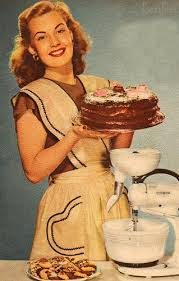
After discussing and making predictions about character, problem and solution, we read the story. We highlighted evidence that Mary Maloney was a stereotypical 1950's house wife.
Students discussed the dramatic irony in the ending of the story and the symobolism in the title.
Using the evidence we collected in the story are completing character sketch assignment.
I discuss how techniques, such as irony, symbolism, perspective and proportion, communicate meaning and enhance effect in oral, print and other media texts 2.2.11
I discuss character development in terms of consistency of behaviour and plausibility of change 2.2.12
I analyze how the choices and motives of characters portrayed in oral, print and other media texts provide insight into those of self and others 2.2.7
Character Sketch
To better understand character we need find evidence and discuss this evidence with our peers. To start, your task is to complete a character sketch for our main character – Mary Maloney. This character sketch will be done in pencil and on a blank piece of paper.
Make sure your first draft includes the following:
List of characteristics (at least 15) – your characteristics should include character motivation, influences, their roles, relationships, attitudes and values
Character Sketch: Rubric Name: Class:
Character Sketch
|
Excellent
|
Proficient
|
Satisfactory
|
Limited
|
I list traits that show Mary’s motivation, influence, roles, relationships, attitudes, and values. 2.2.12
|
List is comprehensive.
All items are covered and provide vivid picture of Mary
|
List is substantial.
All items are covered and provide a complete picture of Mary
|
List is partial.
All items are covered and provide partial picture of Mary
|
List is undeveloped.
Some items are covered and give a unclear picture of Mary
|
State something your teacher should notice about your list:
|
I represent character and discuss how my symbol suits my character’s personality, emotional state or change.
2.2.11, 2.2.12, 2.2.7
|
Symbol is insightful. It represents Mary in a unique way. The explanation of it’s meaning is precise.
|
Symbol is thoughtful. It represents Mary in a interesting way. The explanation of it’s meaning is specific.
|
Symbol is predictable. It represents Mary in a straightforward way. The explanation of it’s meaning is general.
|
Symbol is simplistic. It represents Mary in an ineffective way. The explanation of it’s meaning is lacking or unclear.
|
Something important about my work is…
|
I support my opinion on Mary’s change in character
2.2.12
|
I use significant, precise examples from text to support my opinion.
|
I use relevant, specific examples from text to support my opinion.
|
I use predictable, general examples from text to support my opinion.
|
I use unrelated, brief examples from text to support my opinion.
|
I placed myself at the level above because…
|
"The Most Dangerous Game," by Richard Connell
We exmined historical context to better understand this story better. See task below. Orginally from Sparks Notes but modified for class use.
What is historical context? Why is it important to understanding a story?
I consider historical context when developing own points of view or interpretations of oral, print and other media texts. 2.2.3
I synthesize ideas and information from a variety of sources to develop own opinions, points of view and general impressions 3.1.1
Read this short passage about the historical context for the short story, “The Most Dangerous Game”
Answer the questions and complete the activities
Then create 1 or 2 more questions you still have about this time in history
|
Sparks Notes: Historical Context “The Most Dangerous Game”
One of the main character’s is General Zaroff. General Zaroff’s Cossack background adds historical realism to the development and resolution of the conflict. Cossack is the general name given to a number of peoples in the Ural Mountains region of Eastern Europe in present-day Russia and the Ukraine.
Many Russian Cossacks, such as Zaroff and his assistant, Ivan, were military specialists who fought for centuries as mercenary soldiers in service to the czar (Name for a Russian King) until the collapse of the Russian empire in 1917. The Cossacks played a crucial role in expanding Russia’s borders and maintaining order along the frontier. Deeply feared, Cossacks were infamous for their swift and violent attacks and use of guerilla warfare tactics. Although Connell had no intention of promoting stereotypes in his story, he nevertheless wanted to capitalize on the mythic violence of Cossack warfare to heighten dramatic tension and expose the calculated madness of a single monstrous persona. Connell’s extreme portrayal of the Cossacks thus provides a credible explanation for Zaroff’s otherwise unfathomable motivations for killing.
Zaroff’s Cossack heritage helps us understand his character and gives clues to events that happen later in the story. In 1917, the once heavily persecuted Communists seized power after anarchists overthrew the ruling czar (king) and the entire feudal system in the Russian Revolution.
The newly empowered Soviets turned against the feared Cossacks and tried to exterminate them in a ruthless ethnic cleansing campaign. Zaroff briefly mentions the genocidal campaign to another character which he uses to explain his departure from the Crimea and how he ended up on the remote Ship-Trap Island.
1 or 2 questions I still have about this period of history are…
My general impression of General Zaroff and his situation is…
|
NEXT
Students defined foreshdowing, suspense and irony before reading this haunting story. We annotated the exposition and made predictions for the story.
Many students believed that Rainsford and Whitney would end up on Shiptrap Island and have to survive it's dangers. They thought hunting would be an important part of the story.
While we read students highlighted plot elements to capture Rainsford's experiences on the island. We clarified vocabulary while we read and discussed character traits. Our main purpose was to visualize events as they ocurred in the story. These events we placed on a map after reading.
See the project below:
Students made rough drafts to ensure placement of events was accurate. Then they examined old samples to better understand criteria. See rubric below:
Ship Trap Map: Rubric Name: Class:
Criteria\Level
|
Excellent
|
Proficient
|
Satisfactory
|
Limited
|
I experiment with the language and components of a map to communicate themes or represent the perspectives of a variety of people or characters 4.1.10
Map Components:
Title / Labels
Legend
Compass
Colour
Images / Symbols
Locations
Events
Path
|
Map is comprehensive.
The components of a map are very effective and used to provide a vivid picture of Ship Trap Island and Rainsford’s experiences on the island.
|
Map is substantial.
The components of a map are effectively used to provide a complete picture of Ship Trap Island and Rainsford’s experiences on the island.
|
Map is partial.
The components of a map are sometimes effective and used to provide a partial picture of Ship Trap Island and Rainsford’s experiences on the island.
|
Map is undeveloped.
Few components of a map are effective and used to provide an unclear picture of Ship Trap Island and Rainsford’s experiences on the island.
|
How well do I use map components to represent the Island and Rainsford’s experiences?
|
I use visuals to reinforce the overall impression of the story and engage the audience. 3.4.2
The overall impression of the story is...
|
Visuals are compelling and give a vivid impression of the mood of the story.
|
Visuals are effective and give a clear impression of the mood of the story.
|
Visuals are predictable and give a partial impression of the mood of the story.
|
Visuals lack appeal and give an unclear impression of the mood of the story.
|
How well do I use visuals to reinforce the mood of the story and demand attention from the audience?
|
I develop personal handwriting styles appropriate for a variety of purposes 4.1.6
Handwriting Purposes:
|
I use intriguing handwriting styles for the map title and locations.
I use simple, stylized, neat printing for labels of events.
|
I use interesting handwriting styles for the map title and locations.
I use simple, neat printing for labels of events.
|
I use simplistic handwriting styles for the map title and locations.
I use simple, somewhat neat printing for events.
|
I use handwriting styles that lack appeal for the map title and locations.
I use simple, unclear printing for events.
|
How do my personal handwriting styles suit each purpose?
|
Character Comparison Project
How can I compare one main character in one text to the main character in anothr text from a different era, genre or medium?
Students are rereading to make interprestions about General Zaroff from "The Most Dangerous Game". We are examining his background, personality traits, values and motivations by completing a
character comparison organizer and discussing with our peers.

We'll watch up and identify some of his traits. When we are finished, we'll discuss the similarities between these two characters. We'll also examine film techniques uses to develop Charles Muntz.
The Lost Thing: Theme Analysis
How can I identify and discuss the theme of a story?
Students read the stories in Shaun Tan's "Lost and Found". We explained why these stories fit into the theme (central concept) of Lost and found.
Then we took a closer look at the deeper meaning in the stories. We discussed allegory by watching Dr. Seuss's "Yertle the Turtle"
 |
https://www.amazon.in/Seuss-Yertle-
Turtle-Floor-Puzzle/dp/1572156422 |
- Students discovered that the story of Yertle, specifically his power thirsty ways represent the rise and fall of a well known dictator, Hitler.
Definitions:
- An allegory is the whole story represents a larger concept.
- Symbols are simply objects or colour that represents something else.
We had a lively discussion about the deeper meaning behind "The Lost Thing".
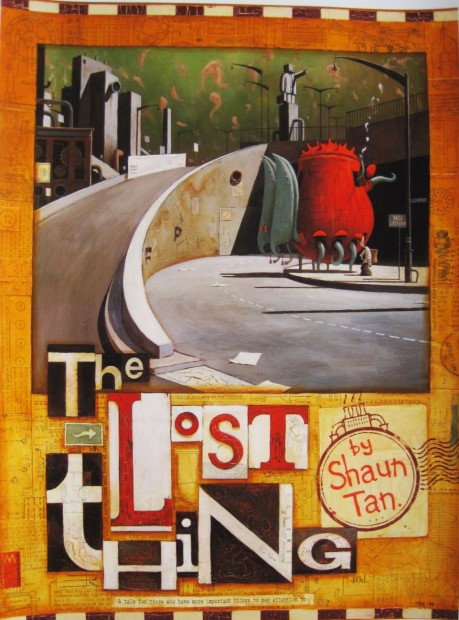 |
| http://thebookwars.ca/2014/04/five-days-with-shaun-tan-day-one-the-lost-thing/ |
Sudents thought that the lost thing and finding it's home could represent the idea that people ignore differences in the world and this makes our lives cold and lonely.
We
practiced writing a theme paragraph for a different story. See first draft thinking below:
Sibling Rivalry or Creative Problem Solving?
“Gore,” written by Sarah Ellis focuses on the sibling rivalry between two twins. They don’t seem to be able to agree on anything which can be troubling to live with on a daily basis. The author’s claim is that sibling rivalry forces young people to find creative solutions to their problems. First, Amy uses blackmail to keep her brother in line. She threatens to tell her parents about the time he photocopied his bum to control him or dissuade him from behaving badly. She is forced to find creative solutions because he is bigger, stronger and faster than she is and he seems to enjoy harassing her. Another tactic she uses is bribery. She tries to convince him to leave her alone by offering to do his backyard poop scooping chores for a week. These solutions offer temporary relief from Lucas’s agressions. Finally, the most creative way Amy is able to solve her problems is using her imagination. She reenacts a scene from the R.L. Tankard novel she is reading. This trickery is deserved as her brother gruffly steals her book simply to antagonize her. Amy successfully gets her book back and is able to retaliate in a way that will make Lucas think twice before provoking his sister again anytime soon. Overall, sibling rivalry can be difficult to deal with on a daily basis, but Amy handles it like a pro and she is a more creative person because of it.
Have I used proper paragraph structure?
Do my ideas flow logically from one to the next?
Are my transitions natural, varied, mechanical or lacking?
Are my ideas wise, logical, those most will have, or without thought?
Is my support precise, specific, general, lacking?
Do I use vocabulary that is vivid, interesting, repetitive, or inaccurate?
Student will be summatively assessed based on the following rubric:
Theme Paragraph: Rubric
Paragraph
|
Excellent
|
Proficient
|
Satisfactory
|
Limited
|
I identify and discuss theme of a story. 2.2.8
Include and identify in text:
|
Provide an insightful analysis of the theme of a story.
Including:
|
Provide an thoughtful analysis of the theme of a story.
Including:
|
Provide a predictable analysis of the theme of a story.
Including:
|
Provide a simplistic analysis of the theme of a story.
Including:
|
The reasons I placed myself at the level above are…
|
I improved my paragraph by using effective transitions between ideas. 4.1.4
BOLD Transitions: First, This means, For example, for instance, to illustrate, furthermore, in addition to, also…
|
I use natural transitions between ideas and maintain a consistent organizational pattern.
|
I use varied transitions between ideas and maintain a consistent organizational pattern.
|
I use mechanical transitions between ideas and maintain an organizational pattern.
|
I use very few transitions between ideas and struggle to maintain organization.
|
Bold 3 of my best transitions in my paragraph. Some new transitions I learned are…
|
My paragraph is clear and easy to understand because all key ideas relate to my topic sentence and concluding sentence links back to main idea. 3.3.3
Clarity means:
Ideas are in a logical order, on topic, flow
My concluding sentence connects back to topic
|
My paragraph is extremely clear and easy to understand.
|
My paragraph is very clear and easy to understand.
|
My paragraph is somewhat clear and easy to understand.
|
My paragraph is not clear and is difficult to understand.
|
Things I can do to improve how clear and easy my paragraph is to understand are…
|













